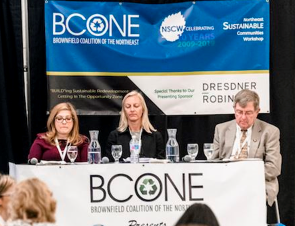Brownfield Coalition of the Northeast (BCONE) Workshop
On June 4, Brownfield Coalition of the Northeast (BCONE) hosted its 10th annual Northwest Sustainable Communities Workshop (NSCW) in Newark, New Jersey.
The goal of the NSCW is to bring together a collection of industry professionals to “break new ground, offer new ideas and concepts on the topics of sustainability, collaboration and leverage, contamination, resiliency, redevelopment challenges, technology, and their impact on community revitalization.” (1)
This year, our very own Heather Boyd, Senior Production Underwriting Manager, had the opportunity to offer her expertise as a panelist on the “Emerging Contaminants & Brownfield Redevelopment, Is it Possible?” panel. The interactive discussion focused on the regulations and developing standards for per-and poly-fluorinated alkylated (PFAS) substances across the country, as well as the discovery of new risk-based research uncovering the dangers these chemicals (or certain strands) have on the environment and human health. Topics that were covered included:
- Understanding PFAS and its current standards
- Litigation and transactional risks associated with PFAS
- Industries as well as properties affected by the outbreak
- How to mitigate the risks

Photo credit: Tommy Sisbarro info@evernorthphotography.com
Heather Boyd, Senior Production Underwriting Manager (center), accompanied by Advances GeoServices Corp. and Holland & Knight LLP, on the “Emerging Contaminants & Brownfield Redevelopment is it Possible?” panel.
During the panel, Heather Boyd spoke about the specific types of policies Great American offers and how PFAS are a considerable factor in underwriting. As such, PFAS pose a major risk in transactions that, if not managed, can result in exorbitant liabilities.
Following the panel, Paul Scian, Senior Loss Control Consultant, took part in a poster session, sharing Great American Environmental Division’s success related to the reuse of brownfields for commercial development and the advantages interim uses provide for community revitalization and engagement.
His overview highlighted hazardous pollution risks at brownfield redevelopment sites and demonstrated how Great American Environmental Division’s core products and services enable businesses, lenders and contractors to effectively and efficiently manage risks that can threaten their financial security.
Our team was honored to be a part of such an impactful event. Thank you, BCONE, for the opportunity. We look forward to attending future gatherings!
To learn more about how we can best protect the interest of your clients, contact your Great American underwriter or any of our office locations to start the conversation.
Learn More About Brownfield Redevelopment
Brownfield redevelopment poses hazardous pollution risk to a variety of participants including:
Owners: Property owners are faced with a host of environmental concerns for sites undergoing remediation, renovation, or redevelopment. Great American Environmental Division works with owners to cover property risks including newly discovered historical releases, property damage, bodily injury, legal expenses, and clean-up costs resulting from pollution conditions associated with a covered location.
Contractors: Contractors face several environmental pollution risks associated with their contracting services. Returning industry and historic properties back to productive use pose special challenges. Great American Environmental Division works closely with contractors to provide the protection for unexpected occurrences during tough projects.
Lenders: A property’s environmental condition is an area of concern for Lenders when evaluating loan applications. Common environmental concerns include:
- Historic property use: Past operations may have impacted the condition of a property through releases that pose residual risks to humans and the environment. Often, these conditions may be unknown and facility expansion or renovation may uncover these existing historic impacts that require costly remediation.
- Current environmental projects: If a property is undergoing environmental remediation, costs can be significant and expand through cost overruns. Remediation projects can impact a borrower’s cash flow and reduce its ability to maintain payments to a lender.
- Existing environmental permits: Statutory protections do not permit a lender to block ongoing expenditures needed to maintain existing permits.If a lender forecloses on a property, decisions and associated costs on operating permits must be made. Secured creditor protections do not allow a lender to block required expenditures to prevent a hazardous, permit exceedance.
- Diminution in value: Property values are negatively impacted by proximity to brownfields. Researchers from the University of Cincinnati had shown a significant decrease in property values for properties located within 2,000 feet of a brownfield, with those located closest to a brownfield displaying the greatest reduction in value.Lenders need to understand the potential for surrounding brownfields to adversely impact the value of a property they may have a security position on.
Contact us to learn more about how Great American Environmental Division’s core products and services enable businesses to effectively and efficiently manage risks that can threaten their financial security.
References:
- https://www.brownfieldcoalitionne.org/nscw-2019